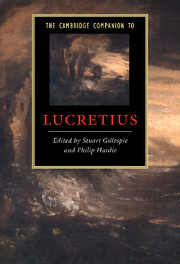Book contents
- Frontmatter
- Introduction
- Part I: Antiquity
- Part II: Themes
- Part III: Reception
- 12 Lucretius in the Middle Ages and early Renaissance: transmission and scholarship
- 13 Lucretius in the Italian Renaissance
- 14 Lucretius in early modern France
- 15 Lucretius in the English Renaissance
- 16 The English voices of Lucretius from Lucy Hutchinson to John Mason Good
- 17 Lucretius in the European Enlightenment
- 18 Lucretius in Romantic and Victorian Britain
- 19 Lucretius and the moderns
- Dateline
- List of works cited
- Index of Main Lucretian Passages Discussed
- General Index
13 - Lucretius in the Italian Renaissance
from Part III: - Reception
Published online by Cambridge University Press: 28 May 2010
- Frontmatter
- Introduction
- Part I: Antiquity
- Part II: Themes
- Part III: Reception
- 12 Lucretius in the Middle Ages and early Renaissance: transmission and scholarship
- 13 Lucretius in the Italian Renaissance
- 14 Lucretius in early modern France
- 15 Lucretius in the English Renaissance
- 16 The English voices of Lucretius from Lucy Hutchinson to John Mason Good
- 17 Lucretius in the European Enlightenment
- 18 Lucretius in Romantic and Victorian Britain
- 19 Lucretius and the moderns
- Dateline
- List of works cited
- Index of Main Lucretian Passages Discussed
- General Index
Summary
The dissimulatory code
There are two critical moments for the reception of the DRN in the Italian Renaissance. The first is 1417, the year in which Poggio rediscovered the text of Lucretius; the second comes in the early decades of the sixteenth century, when religious conflict led to the rigorous censorship of secular culture. The cultural and political circumstances of Counter-Reformation Italy created a threat that the DRN, ‘restored from death to life’ by Poggio, might once more be consigned to oblivion because of its Epicureanism and its anti-providential materialism. In the event, as witnessed by its uninterrupted influence on Italian literature of the fifteenth and sixteenth centuries, readership of the DRN showed no falling off after the Counter-Reformation. This is because, when faced with a text as risky and as alluring as the DRN, Lucretius’ admirers spontaneously adopted measures of self-censorship which collectively can be called a ‘dissimulatory code’, in order to head off the far more threatening censorship of the Church. The self-imposed cautiousness of its readers had two main consequences for the reception of the poem. In the short term this provided a defence against the risk of an official condemnation of Lucretius; but, in the long run, the dissimulatory code brought about a change not only in the nature of the response to the DRN but also in the perceptions of later centuries, leading sometimes to the assumption that there is little to report of sixteenth-century responses to the DRN.
- Type
- Chapter
- Information
- The Cambridge Companion to Lucretius , pp. 214 - 226Publisher: Cambridge University PressPrint publication year: 2007
- 9
- Cited by

